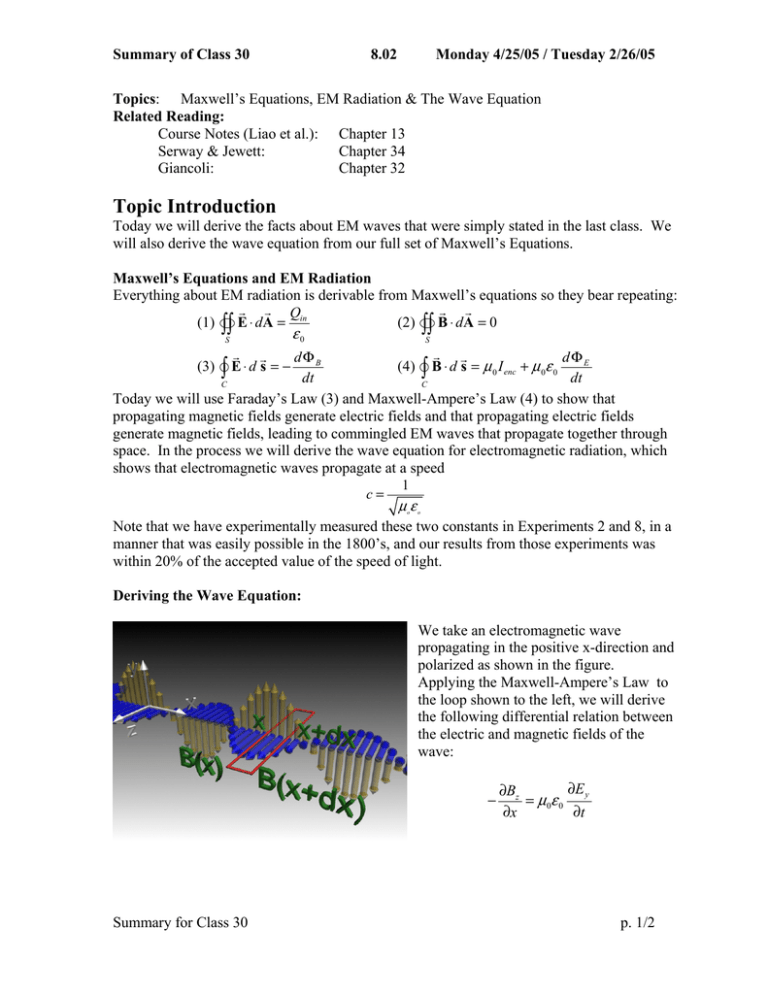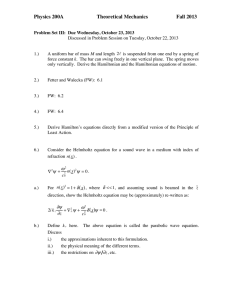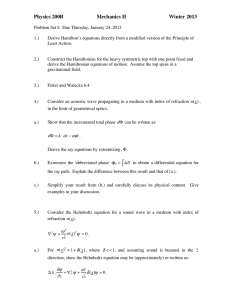Summary of Class 30 8.02 Monday 4/25/05 / Tuesday 2/26/05 Topics
advertisement

Summary of Class 30 8.02 Monday 4/25/05 / Tuesday 2/26/05 Topics: Maxwell’s Equations, EM Radiation & The Wave Equation Related Reading: Course Notes (Liao et al.): Chapter 13 Serway & Jewett: Chapter 34 Giancoli: Chapter 32 Topic Introduction Today we will derive the facts about EM waves that were simply stated in the last class. We will also derive the wave equation from our full set of Maxwell’s Equations. Maxwell’s Equations and EM Radiation Everything about EM radiation is derivable from Maxwell’s equations so they bear repeating: G G Qin G G d (1) w E ⋅ A = (2) B ∫∫S w ∫∫S ⋅ dA = 0 ε0 G G G G dΦB dΦE (3) v∫ E ⋅ d s = − (4) v∫ B ⋅ d s = µ 0 I enc + µ 0ε 0 dt dt C C Today we will use Faraday’s Law (3) and Maxwell-Ampere’s Law (4) to show that propagating magnetic fields generate electric fields and that propagating electric fields generate magnetic fields, leading to commingled EM waves that propagate together through space. In the process we will derive the wave equation for electromagnetic radiation, which shows that electromagnetic waves propagate at a speed c= 1 µε Note that we have experimentally measured these two constants in Experiments 2 and 8, in a manner that was easily possible in the 1800’s, and our results from those experiments was within 20% of the accepted value of the speed of light. o o Deriving the Wave Equation: We take an electromagnetic wave propagating in the positive x-direction and polarized as shown in the figure. Applying the Maxwell-Ampere’s Law to the loop shown to the left, we will derive the following differential relation between the electric and magnetic fields of the wave: − Summary for Class 30 ∂E ∂Bz = µ 0ε 0 y ∂x ∂t p. 1/2 Summary of Class 30 8.02 Monday 4/25/05 / Tuesday 2/26/05 For the same wave as show above, applying Faraday’s Law to the loop shown to the left, we will derive another differential relation between the electric and magnetic fields of the wave: ∂E y ∂x =− ∂Bz ∂t If we then combine the two relations we have above, we find that the electric field of the wave must satisfy the one dimensional wave equation ∂2 Ey ∂x 2 = µ 0ε 0 ∂2 Ey ∂t 2 The solutions to this equation are waves propagating at the speed of light. We will also derive the relations we have previously stated between the magnitudes and direction of E and B. Important Equations G G Qin E w ∫∫ ⋅ dA = (2) G G dΦB (3) v∫ E ⋅ d s = − dt C (4) (1) Maxwell’s Equations: EM Plane Waves: 1D Wave Equation: Summary for Class 30 ε0 S G G G E ( r , t ) = E0 sin ( kpˆ ⋅ r − ω t ) Eˆ G G G B ( r , t ) = B0 sin ( kpˆ ⋅ r − ω t ) Bˆ ∂2 Ey ∂x 2 = µ 0ε 0 G G B w ∫∫ ⋅ dA = 0 S G G dΦ B vC∫ ⋅ d s = µ 0 I enc + µ 0ε 0 dt E with E0 = cB0 ; Eˆ × Bˆ = pˆ ; ω = ck ∂2 Ey ∂t 2 p. 2/2





